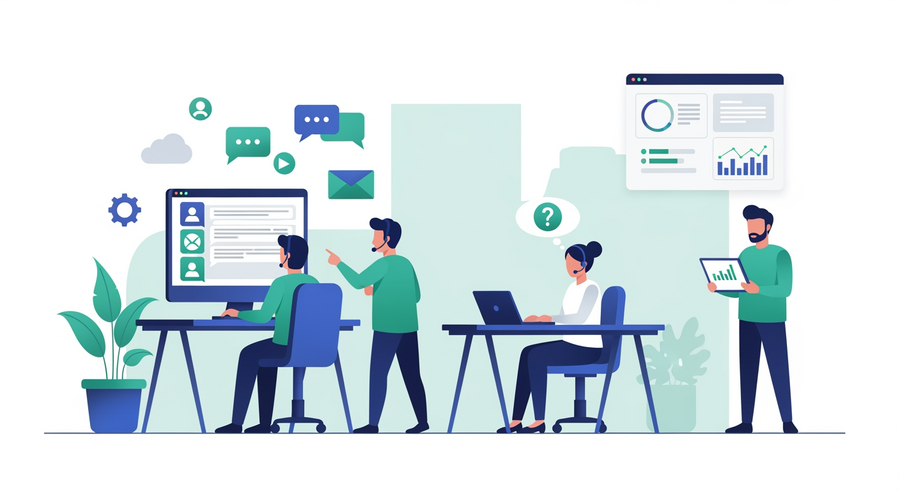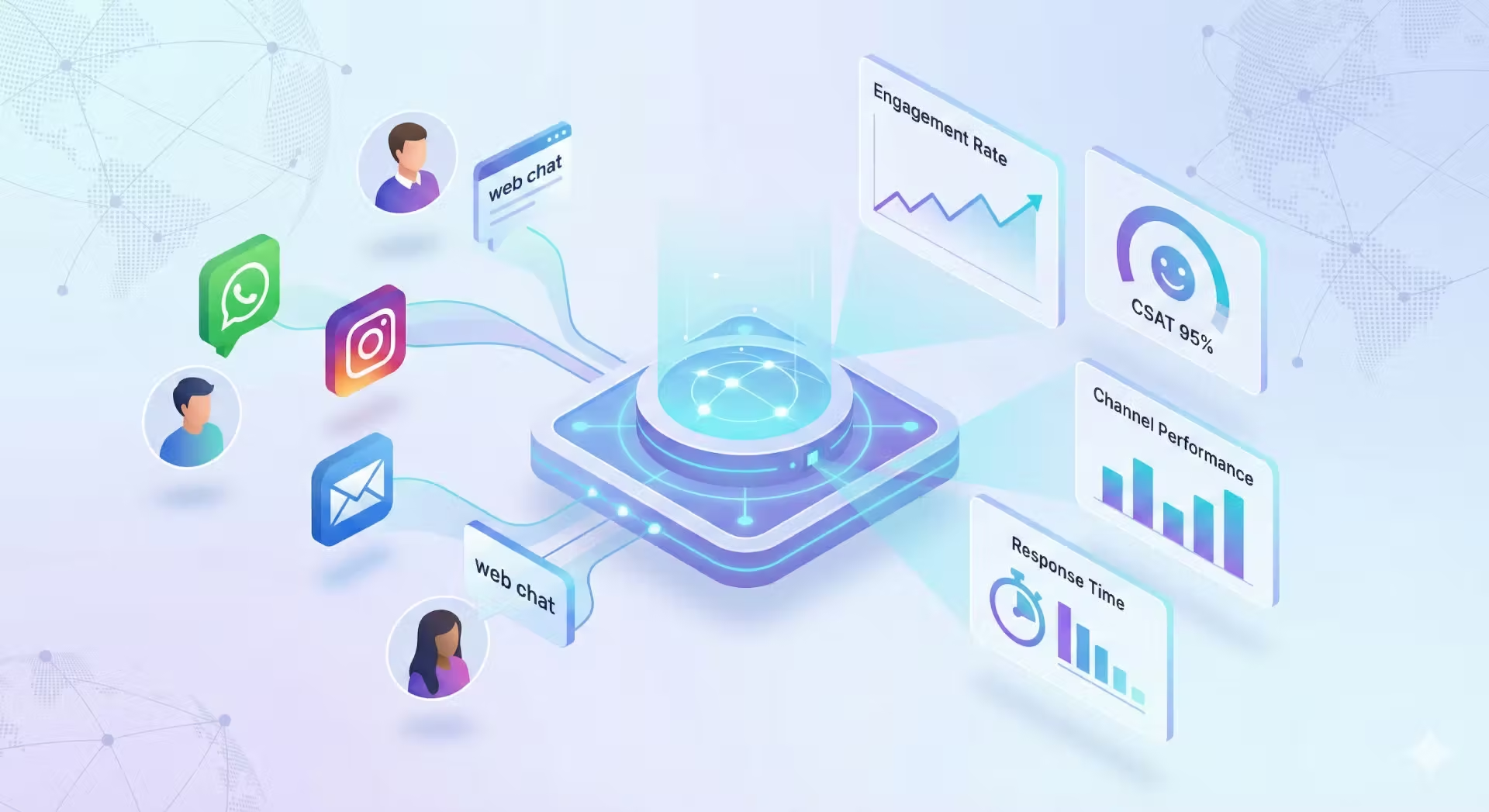Let’s dive right in: a customer service widget seamlessly integrates into your website or app, providing immediate support directly on websites. That makes, setting up a widget not only about lightning-fast answers to your customer's questions but also about a complete shift in how you deliver customer service.
With widgets, real-time help is at your customers' fingertips, removing barriers in the buying process and improving their online experience.
So yes, customer service widgets make each interaction faster but that's not where the benefits end. What’s important for customer experiences is that you’re team will be able to deliver tailored and intuitive responses to your customer's inquiries. A whopping 52% of consumers are more likely to remain loyal to a company that offers live chat support. From solving problems on the spot to giving quick access to FAQs, widgets are a step towards more proactive and personalised customer care.
Let's explore how implementing a widget in your customer service strategy can redefine your support and improve customer relations. Plus how to make every interaction more efficient and engaging, saving your team time and giving your business an edge in the competitive world of customer satisfaction.
Understanding customer service widgets
A website widget is a tool that you can embed into your website or app. It's like a mini-application that lives on your site, designed to enhance the user experience without visitors having to leave the page they are on.
Customer service widgets apply this concept directly to your support strategy. These widgets can be things like:
- Live Chat
- Feedback forms
- FAQs
- Support bots
Each customer service widget has a specific purpose that smooths out interactions between you and your customers. Their main job? To provide immediate help, answer questions, and guide users through your services, all without interrupting their browsing experience.
Integrating customer service widgets into your website or application is relatively straightforward. Most widget providers offer a simple code snippet that you paste into your site's HTML.
Winning duo: combining a customer service widgets and Live Chat
The real magic happens when you combine your widgets with Live Chat functionality. This duo transforms your website into a top-tier support hub, where live agents and automated support work hand in hand to offer 24/7 assistance.
Let's say that a customer comes to your website outside of business hours and has a question about a product. Instead of leaving them to navigate through help articles or wait for email support, an automated chat widget can give them instant answers to common questions or even guide them through troubleshooting steps.
And even when the query is too complex for the widget, it can collect the customer's information and then a member of your customer service team can follow up as soon as they're available.
This approach not only maximises the efficiency of your customer service team — allowing them to focus on more complex inquiries — but also improves the customer experience. CM’s Customer Service Report found that the top three annoyances in customer service are:
1. Long waiting times
2. Having to repeat yourself
3. Difficulty to reach
By providing immediate answers through automated widgets and the option for deeper, more personalised assistance through Live Chat, you can avoid all three.
Key features and benefits of a customer service widget
Why your business needs a widget
Great service is not just about speed, but… let’s be honest it is still a very important part of it. Quick service will help you stay ahead in the race, and luckily customer service widgets give you a range of features that can help you come in first.
- Live Chat: response with real-time interactions that allow customers to get instant answers to their questions.
- Knowledge base access: give customers immediate access to articles and FAQs, that can help them to find answers without the need for a human to help.
- Support: enable customers to quickly and simply raise support questions directly through your widget if their problem cannot be resolved with the automated responses and FAQs
- Integration with CRM systems: ensure that every customer interaction is logged and accessible, providing a 360-degree view of the customer journey and allowing for more personalised responses.
Enhance team efficiency
With these features, customer service widgets improve your customer service team's efficiency. Here’s how:
- Real-time assistance: Live Chat functionality ensures customers are not left waiting, leading to higher satisfaction rates.
- Prompt issue resolution: immediate access to a knowledge base and ticket submission streamlines the resolution process.
- Personalised interactions: CRM integration allows agents to view customer histories, tailoring conversations to meet individual customer needs.
- Seamless collaboration: with easy access to customer data and histories, teams can work together more effectively to resolve issues faster.
For example, a customer struggling with an online payment could use Live Chat to get immediate help, avoiding frustration and potential cart abandonment. Meanwhile, another customer browsing FAQs about a product could be encouraged to chat with a live agent for more details, seamlessly blending automated and personal support.
Attract new customers
The presence of a customer service widget on your website serves as a signal that your business is accessible and responsive, helping to build initial trust and a good reputation with new customers. It signals to potential customers that your business prioritises their needs and is ready to assist them at any moment.
This immediate access to support can also help speed up pushing customers through your funnel by providing answers exactly when they're looking for them.
💡For example, H&M implemented an AI chatbot on its website to provide customer support. The chatbot reduced customer wait times by 20 seconds and led to a 15% increase in online sales.
You can use your widget to prevent potential customers from drifting away or turning to competitors due to unanswered product queries. This instant support ensures that any hesitations in the buying process are addressed immediately, keeping the customer engaged and moving them from consideration to purchase within your sales funnel.
Increase lead generation
Through engaging chat interactions, you can capture visitor information, qualifying leads based on their queries and interests. For example, a visitor asking detailed questions about a specific service could be flagged as a high-interest lead, enabling targeted follow-up communications. Additionally, proactive chat invitations based on browsing behaviour can guide potential leads towards products or services that match their interests, increasing conversions.
How do others use a website widget? An example
Billink’s Transformation with Trengo's widget
Background
Billink is a prominent buy now, pay later service in the Netherlands. It was recognised as the best alternative payment method in 2021 and 2022 and has catered to over 2 million customers in the Netherlands and Belgium, supported by 3,000 sales partners.
Challenge
For Billink, earning and maintaining customer trust is of the utmost importance. Operations Manager Bart den Outer emphasizes the importance of enhancing customer trust and experience. The challenge was to improve efficiency without compromising the quality of customer service, ensuring easy and fast communication for customers.
Solution
In their quest for an efficient customer engagement solution, Billink discovered Trengo. Making the switch from Freshdesk, they were drawn to Trengo's automation capabilities and the simplicity of having a unified inbox.
This transition enhanced internal communication and collaboration across various departments of the business. A key component of this transformation was the integration of a chatbot widget within Trengo’s platform. This chatbot widget has been instrumental in managing customer interactions more dynamically, allowing for real-time conversations that guide customers through queries or issues swiftly. Coupled with features like internal notes and tagging, the team now delivers quicker, more efficient resolutions to customer inquiries, improving overall service quality.
Results
Trengo revolutionised Billink’s customer service, enabling the team to do WhatsApp inquiries within five minutes and Live Chat within three minutes. The switch to Trengo not only simplified the system for employees but also upheld Billink's commitment to exceptional customer service.
Widget automations
Beyond examples such as Billink, companies can leverage customer service widgets in various impactful ways. Trengo’s widget automation offer numerous ways to go from a traditional reactive model to a proactive, engaging journey. So better your customer experience and:
- Greet visitors: personalised Live Chat greetings not only welcome visitors but can also provide targeted messages or discount codes.
- Flowbot integration: connecting a flowbot to the widget ensures immediate engagement, allowing for data collection and query resolution.
- Help centre article access: this automation directs users to relevant help articles within the widget, catering to specific inquiries or page visits.
Implement customer service widgets: expert advice and insights
Customer service is being enhanced daily, think about widgets, apps, social media integrations, and seamless payment systems leading the way. Some organisations have been leaping ahead and embracing technology, while others are yet to catch up.
The challenge isn't just about adopting new technologies such as customer service widgets; it involves understanding how to effectively integrate these new customer engagement opportunities into your existing strategy and building a team that can make the most out of these technologies.
In five-step a good widget, and even better customer experience
Drawing on successful strategies that we have seen clients from the hospitality, travel, leisure, automotive and other industries use, the following five-step approach can help you navigate implementing a customer service widget.
1. Set precise objectives
Start by defining explicit, measurable objectives for incorporating customer service widgets. Focus on specific goals such as:
- Reducing response times
- Increasing customer satisfaction scores,
- Boosting self-service resolution rates
These goals should directly relate to improving the customer experience and operational efficiency.
2. Analyse key performance indicators (KPIs)
Look at which operational elements are influencing your targeted KPIs. This might involve examining factors like widget placement, types of queries handled by AI vs. human agents, and the integration depth with CRM systems. When you figure this out you will be able to focus your strategy on areas for improvement that will have the most impact.
3. Implement your impactful changes
Simulate various widget configurations and features to identify which modifications will have the biggest positive impact on your KPIs. Whether it’s automating FAQs, streamlining ticket submission, or enabling direct chat support, prioritise changes that align with your objectives and that will have a notable impact.
4. Conduct market research for solutions
Stay up-to-date on the latest in widget technology and best practices, but let your defined needs lead your search for solutions. The goal is to find a widget or suite of widgets that addresses your specific challenges, rather than adapting your strategy to fit the capabilities of the latest tool on the market. It can be tempting when you see competitors using fancy new technology to implement something similar, but if it's not what your customers will use, it will be a poor investment.
5. Monitor and adjust based on performance
A customer service widget isn’t a set-it-and-forget-it customer service strategy. Continuously track the performance of your widget against the KPIs you’ve set. Use this data to refine and adjust your strategy, widget integration with other tools, or even its interface design to better meet your customers' needs.
Offer a great experience in real-time with your customer service widget
It’s clear that customer service widgets are not just add-ons but essential elements if you want to improve your service delivery and the customer experience.
When integrated thoughtfully with your existing systems, widgets will meet customer expectations and… well make them happy by offering immediate, personalised support directly where your customers are engaging with your brand.




.png)











